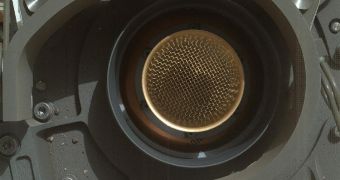Mission controllers at the NASA Jet Propulsion Laboratory (JPL) in Pasadena, California, announce that the robotic arm aboard the Mars Science Laboratory (MSL) rover Curiosity has very nearly finished going through its testing and commissioning phase.
The purpose of this phase is to assess how the 2.1-meter (7-foot) limb behaves at Martian temperatures and gravity levels. While especially designed to operate in these conditions, one can never be too careful, the team explains.
Once these tests are complete, the rover will be able to scoop up its first Martian soil samples, for analysis. But before this can happen, scientists in charge of the mission need to ensure that the robotic arm moves precisely and smoothly.
Curiosity's first science target is called Glenelg, and is located about 400 meters (1,300 feet) from Bradbury Landing. This is where the rover was first deposited on the Martian surface by the Sky Crane.
However, the instruments on the robotic arm will be used even before the rover reaches Glenelg. Since that target is an outcrop featuring three different types of rocks, experts want to be able to conduct actual investigations once they reach it.
“We're about to drive some more and try to find the right rock to begin doing contact science with the arm” JPL Curiosity mission manager, Jennifer Trosper, explains. She explains that the arm has two main scientific instruments.
The Mars Hand Lens Imager (MAHLI) is responsible for snapping close-up, color images of Curiosity's targets. Afterwards, the Alpha Particle X-Ray Spectrometer (APXS) is used to reveal the chemical composition of the targeted soils.
“The spectrum peaks are so narrow, we're getting excellent resolution, just as good as we saw in tests on Earth under ideal conditions,” explains the primary investigator of the APXS instrument, University of Guelph expert Ralf Gellert.
“The good news is that we can now make high-resolution measurements even at high noon to support quick decisions about whether a sample is worthwhile for further investigations,” he goes on to say.
“Honestly, seeing those images with Curiosity's wheels in the foreground and Mount Sharp in the background simply makes me cry. I know we're just getting started, but it's already been an incredible journey,” says Ken Edgett.
The expert is based at Malin Space Science Systems, in San Diego, the company that built MAHLI. He is also the principal investigator for the instrument, which returned its first full-resolution images last week.

 14 DAY TRIAL //
14 DAY TRIAL //